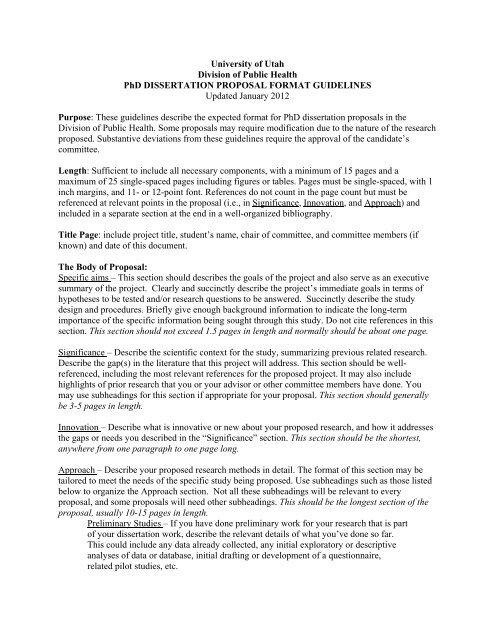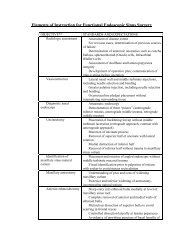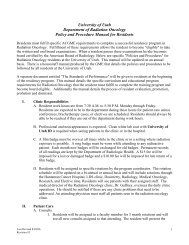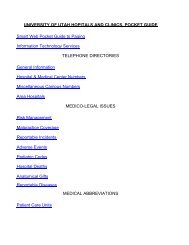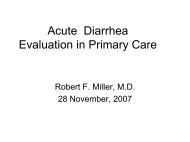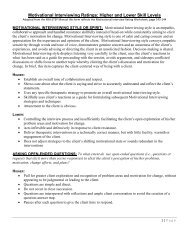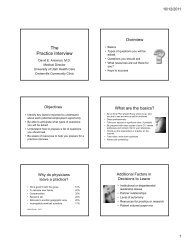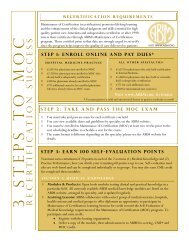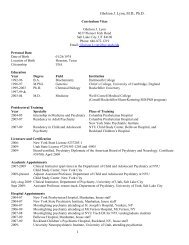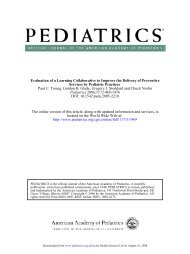PhD Full Dissertation Proposal Format Guidelines - University of ...
PhD Full Dissertation Proposal Format Guidelines - University of ...
PhD Full Dissertation Proposal Format Guidelines - University of ...
Create successful ePaper yourself
Turn your PDF publications into a flip-book with our unique Google optimized e-Paper software.
<strong>University</strong> <strong>of</strong> Utah<br />
Division <strong>of</strong> Public Health<br />
<strong>PhD</strong> DISSERTATION PROPOSAL FORMAT GUIDELINES<br />
Updated January 2012<br />
Purpose: These guidelines describe the expected format for <strong>PhD</strong> dissertation proposals in the<br />
Division <strong>of</strong> Public Health. Some proposals may require modification due to the nature <strong>of</strong> the research<br />
proposed. Substantive deviations from these guidelines require the approval <strong>of</strong> the candidate’s<br />
committee.<br />
Length: Sufficient to include all necessary components, with a minimum <strong>of</strong> 15 pages and a<br />
maximum <strong>of</strong> 25 single-spaced pages including figures or tables. Pages must be single-spaced, with 1<br />
inch margins, and 11- or 12-point font. References do not count in the page count but must be<br />
referenced at relevant points in the proposal (i.e., in Significance, Innovation, and Approach) and<br />
included in a separate section at the end in a well-organized bibliography.<br />
Title Page: include project title, student’s name, chair <strong>of</strong> committee, and committee members (if<br />
known) and date <strong>of</strong> this document.<br />
The Body <strong>of</strong> <strong>Proposal</strong>:<br />
Specific aims – This section should describes the goals <strong>of</strong> the project and also serve as an executive<br />
summary <strong>of</strong> the project. Clearly and succinctly describe the project’s immediate goals in terms <strong>of</strong><br />
hypotheses to be tested and/or research questions to be answered. Succinctly describe the study<br />
design and procedures. Briefly give enough background information to indicate the long-term<br />
importance <strong>of</strong> the specific information being sought through this study. Do not cite references in this<br />
section. This section should not exceed 1.5 pages in length and normally should be about one page.<br />
Significance – Describe the scientific context for the study, summarizing previous related research.<br />
Describe the gap(s) in the literature that this project will address. This section should be wellreferenced,<br />
including the most relevant references for the proposed project. It may also include<br />
highlights <strong>of</strong> prior research that you or your advisor or other committee members have done. You<br />
may use subheadings for this section if appropriate for your proposal. This section should generally<br />
be 3-5 pages in length.<br />
Innovation – Describe what is innovative or new about your proposed research, and how it addresses<br />
the gaps or needs you described in the “Significance” section. This section should be the shortest,<br />
anywhere from one paragraph to one page long.<br />
Approach – Describe your proposed research methods in detail. The format <strong>of</strong> this section may be<br />
tailored to meet the needs <strong>of</strong> the specific study being proposed. Use subheadings such as those listed<br />
below to organize the Approach section. Not all these subheadings will be relevant to every<br />
proposal, and some proposals will need other subheadings. This should be the longest section <strong>of</strong> the<br />
proposal, usually 10-15 pages in length.<br />
Preliminary Studies – If you have done preliminary work for your research that is part<br />
<strong>of</strong> your dissertation work, describe the relevant details <strong>of</strong> what you’ve done so far.<br />
This could include any data already collected, any initial exploratory or descriptive<br />
analyses <strong>of</strong> data or database, initial drafting or development <strong>of</strong> a questionnaire,<br />
related pilot studies, etc.
Study setting – Describe the location, organizational context, clinical site(s), or other<br />
setting in which the research would take place.<br />
Study subjects – Indicate the source(s) <strong>of</strong> study subjects, inclusion and exclusion<br />
criteria, and the anticipated number to be studied.<br />
Intervention– If an intervention is to be implemented and/or evaluated, describe it.<br />
Data collection – Describe the sources <strong>of</strong> key data items on each subject. When<br />
applicable, the sequence <strong>of</strong> data collection activities for a typical subject should be<br />
given. A diagram can be helpful when data will come from several sources or when<br />
multiple observations over time are to be obtained. If there are plans to monitor and<br />
assure data quality (such as duplicate data for some or all subjects, cross-checks <strong>of</strong><br />
one data source against another, or other techniques), describe them briefly. Also<br />
specify what role you, the doctoral candidate, will play in data collection.<br />
Measures – Describe the instruments or measurements used, and what ways they<br />
have been validated in past studies, or will be validated in this study.<br />
Data analysis – Describe how the data will be organized to address each <strong>of</strong> the<br />
specific aims, indicating the statistical techniques to be used. Dummy tables or<br />
figures may be helpful.<br />
Sample Size and Power – Summarize the results <strong>of</strong> statistical power or sample-size<br />
calculations.<br />
Human Subjects – Describe whether an IRB approval has been obtained or when and how it will be<br />
obtained. Described the risks and benefits for human subjects to participate in this research. Address<br />
the inclusion or exclusion <strong>of</strong> racial or ethnic minorities, women, children, and vulnerable populations<br />
(such as pregnant women, prisoners, critically ill persons, or mentally incompetent persons) from this<br />
study, and the rationale for their inclusion or exclusion. This section should usually be about 1 page<br />
in length.<br />
Outlines <strong>of</strong> Papers – Give a succinct working title and description or outline for each <strong>of</strong> the 3 papers<br />
to be generated from this work in fulfillment <strong>of</strong> the dissertation requirements. This section should<br />
usually be 1.5 to 3 pages in length.<br />
References cited – Provide citations to key literature references used in the proposal. The exact<br />
number <strong>of</strong> references will depend on the topic <strong>of</strong> research, but there should be a minimum <strong>of</strong> 15<br />
references, and there will <strong>of</strong>ten be many more. There is no page limit for this section.


